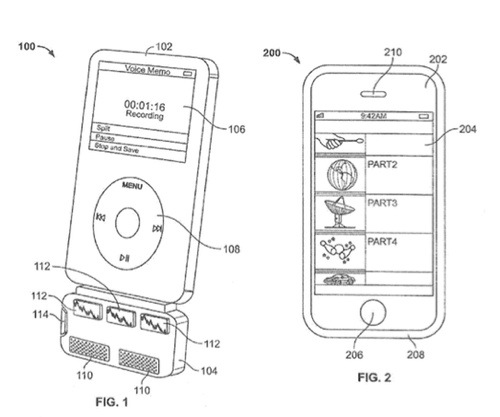An Apple patent (number 20120249312) for tactile feedback in an electronic device has appeared at the U.S. Patent & Trademark Office. It’s designed for using iOS devices in dark environments — and to help users of such devices who have poor vision.
Per the patent, the electronic device may provide tactile feedback using any suitable approach, including for example vibration, heat, electrical, visual, or any other type of feedback. The electronic device may provide tactile feedback in response to detecting any particular status of the electronic device, receiving any particular input, or detecting any suitable communication received by the electronic device.
For example, the electronic device may provide tactile feedback in response to identifying the current network of the device, the status of a particular electronic device component, or any other electronic device status. As another example, the electronic device may provide tactile feedback in response to receiving a particular type of communication, or in response to receiving a communication from a particular contact.
Here’s Apple’s background and summary of the invention: “Portable electronic devices have shrunk while providing ever more functionality. Because the devices are smaller, users can more easily carry them, and use them in a variety of situations where larger, less portable electronic devices could be more difficult to use. An effect of the decrease in size of electronic devices has been a decrease in the size of input mechanisms for providing instructions to the electronic device, and a decrease in the size of displays or screens used to navigate the electronic devices and to access the electronic device functions.
“For some users, including for example users with poor vision, or users in dark environments (e.g., at night with little or no electronic device backlight), the reduction in size of the input mechanism and display inconveniences the users and may prevent the users from properly using the electronic device, thus leading to frustration. To remedy these limitations, electronic device manufacturers have spent much effort in creating electronic device interfaces with an emphasis on ease of use and intuitiveness.
“Some electronic devices provide tactile feedback to users in limited circumstances. For example, some electronic devices vibrate when a telephone call or text message is received. As another example, some electronic devices may vibrate in response to receiving a user selection of a vibration instruction (e.g., a vibrate button).
“An electronic device for providing tactile feedback to a user in response to detecting a particular state of the device, or in response to detecting a particular user input is provided. Using tactile feedback, the electronic device may supplement one or more menus, selectable options, or other user interface features to facilitate the use of the electronic device.
“The electronic device may be operative to provide any suitable tactile feedback. For example, the electronic device may provide vibration feedback. The electronic device may vibrate using any suitable approach. For example, one or more vibrating components integrated in the electronic device may vibrate at particular times. The vibrating components may be operative to cause the entire electronic device to vibrate, or only portions of the electronic device (e.g., the portion of the screen under the user’s finger) to vibrate.
“As another example, the electronic device may provide temperature or heat-based tactile feedback (e.g., change the temperature of one or more portions of the electronic device), electrical tactile feedback (e.g., small, localized or general electrical discharges). In some embodiments, the electronic device may simultaneously provide different types of tactile feedback, visual feedback, audio feedback, olfactory feedback, or any other suitable combination of feedback.
“The electronic device may provide tactile feedback at any suitable time. In some embodiments, the electronic device may provide tactile feedback based on communications operations available to the device. For example, the electronic device may provide tactile feedback in response to detecting a particular type of communications network, or receiving a particular communication (e.g., a particular type of communication, or a communication from a particular source).
“As another example, the electronic device may provide tactile feedback in response to determining the current status of an ongoing communications operation (e.g., the duration of the communications operation, or the amount of data received or sent). As still another example, the electronic device may provide tactile feedback in response to determining the current amount of communications credit remaining in a user’s account.
“In some embodiments, the electronic device may provide tactile feedback in response to detecting the user’s hands on the electronic device. For example, the electronic device may provide tactile feedback in response to detecting a user’s finger over a particular displayed option (e.g., a key of a keyboard or keypad, or a particular selectable option of an application). As another example, the electronic device may provide tactile feedback to guide the user in entering text on the electronic device (e.g., provide tactile feedback to identify the position of a displayed line, word, character or cursor). As still another example, the electronic device may provide tactile feedback to assist the user in navigating displayed menu options.
“In some embodiments, the electronic device may be operative to provide tactile feedback based on the status of the electronic device. For example, the electronic device may provide tactile feedback in response to determining the amount of memory available, the battery life, the processor or bus speed, or any other resource of the electronic device. As another example, the electronic device may provide tactile feedback based on the location of the user (e.g., provide tactile feedback to guide a user along a path, or to a particular destination). As still another example, the electronic device may provide tactile feedback in response to detecting the environment in which the device is found (e.g., based on a proximity sensor or an accelerometer).”
The inventors are Anthony Fadell, Andrew Hodge, Stephen Zadesky, Aram Lindahl and Anthony Guetta.

